Callaeas cinereus (J. F. Gmelin, 1788:363)
South Island kokako, Orange-wattled crow, Orange wattled crow, Kōkā (Māori)
Taxonomy & Nomenclature
A complete synonymy taken from (Checklist Committee (OSNZ), 2022:207-208):
Glaucopis cinerea Gmelin, 1788: Syst. Nat., 13th edition 1(1): 363. Based on the “Cinereous Wattle-bird” of Latham 1781, Gen. Synop. Birds 1: 364, pl. 14 – Queen Charlotte Sound, Marlborough.; Cryptorhina Callaeas Wagler, 1827: Syst. Avium 1: sp. 5 – New Zealand.; Callaeas cinerea (Gmelin); G.R. Gray 1843, in E. Dieffenbach, Travels in N.Z. 2: 191.; Callaeas cenerea Gmelin [sic]; Anon. 1870, Cat. Colonial Mus.: 73. Unjustified emendation.; Callaeas cinerea cinerea (Gmelin); Checklist Committee 1953, Checklist N.Z. Birds: 68.; Callaeas cinereus (Gmelin); Dickinson & Christidis 2014, Howard & Moore Complete Checklist Birds World, 4th edition, 2: 174.
Conservation Status
Missing
Last record: c.1947-48 (Stewart Island) (second hand report) (Martin, 1950); 1958 (Otago, South Island) (Scott, 1965); 1961 (South Island); 1967 (Clout & Hall, 1981; McBride, 1981; Tyrberg, 2009:103; Kittelberger et al., 2024); 2007 (Martin et al., 2023)
IUCN RedList status: Critically Endangered (Possibly Extinct)
The South Island kokako (top) is one of two species of the Kokako, the other being the North Island Kokako (below). A late sighting from 15 February, 1958, in the Wilkin Valley (Chapman, 1959). The last known sighting of the South Island Kokako is either January 1961 (Read, 1966) or 1967 in the Teal Valley, Mt Aspiring National Park (Clout & Hall, 1981; McBride, 1981). Interestingly, a secondhand record from Stewart Island in the 1940's exists (Martin, 1950).
Innumerable reported sightings have been made since 1967, which appear to invariably post-date 1989. Milne & Stocker (2014) compiled a list of 241 reports between January 1990 and June 2012 (see their [url=https://notornis.osnz.org.nz/system/files/Milne%20%26%20Stocker%20supplementary.pdf]supplementary information[/url]). In an unprecedented move, the OSNZ Records Appraisal Committee accepted a report from March 2007 (Miskelly et al. 2013:300-301) as confirming the persistence of this species. This was followed by (BirdLife International, 2016), although they listed the species as "possibly extinct", following (Bain, 2009) in considering recent reports "not deemed to be credible".
However, no specimen or photographic or videographic evidence has been produced in decades, a scientific standard that is (almost) universally upheld in order to confirm a rediscovery. In addition, the fact that almost all reports appear to post-date 1989 is interesting. One possible explanation is that this reporting bias is due to increased publicity of the species, however that would only explain why reports are being made now, not why the sightings themselves have only been made post-1989. Another explanation is that an increased human population (or at least that which comes into contact with the relevant habitat) now encounters the species more often. This wouldn't explain the apparent severe disjunction between pre-1990 and post-1989 reports.
The most natural explanation is that the increased reports coincide with an increased Kokako population, from near extinction to today's seemingly healthy population. However, this is inconsistent with the complete lack of objective (i.e. non-eyewitness) evidence of the species. In conclusion then, many of the recent reports are the result of misidentification, perhaps of released or vagrant North island kokako's. If the South Island kokako survives at all, the global population is likely to be extremely small and may not even be viable. It is listed as extinct in the official "Amendments to the 2010 Checklist of the birds of New Zealand" published by the Ornithological Society of New Zealand (Miskelly et al., 2022).
Distribution
South Island & Stewart Island, New Zealand
Biology & Ecology
Hypodigm
At least 1 specimen is in the Museum of New Zealand Te Papa Tongarewa ornithological collection.
OR.029158 (collected January 1873)
ZMA 6594 (adult; sex unspecified)
ZMA 6595 (adult male)
Media
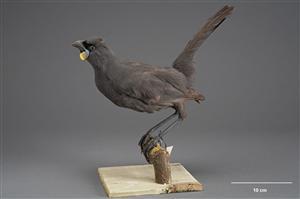
Above: Reproduced courtesy of Museum of New Zealand Te Papa Tongarewa.
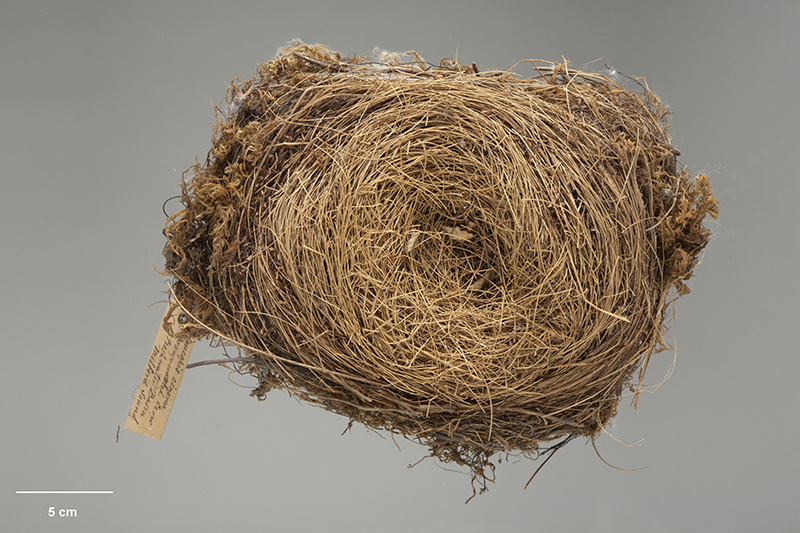
Above: South Island Kokako, Callaeas cinerea, collected January 1873, Freshwater Basin, Milford Sound, New Zealand. CC BY 4.0. Te Papa (OR.029158)
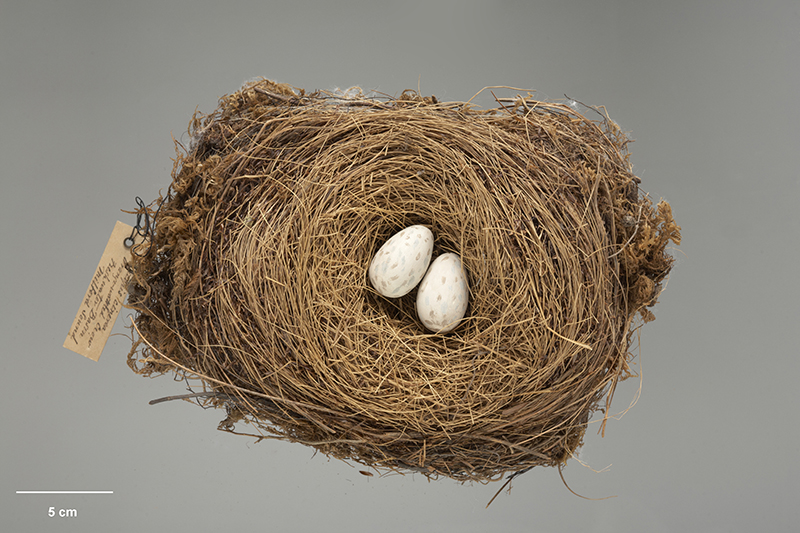
Above: South Island Kokako, Callaeas cinerea. CC BY 4.0. Te Papa (OR.029159)
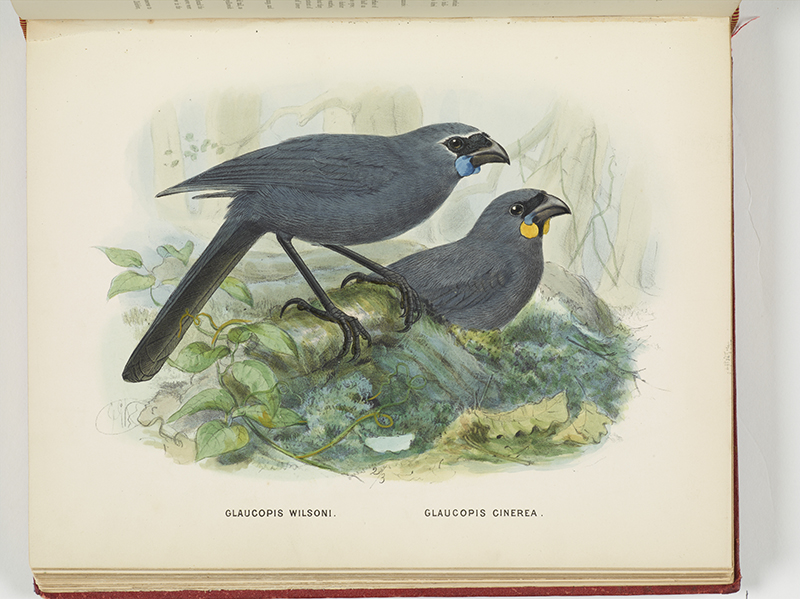
Above: Glaucopis wilsoni and Glaucopis cinerea. Plate 17. From the book A history of the birds of New Zealand., 1873, by Johannes Keulemans. Te Papa (RB001176/017a)
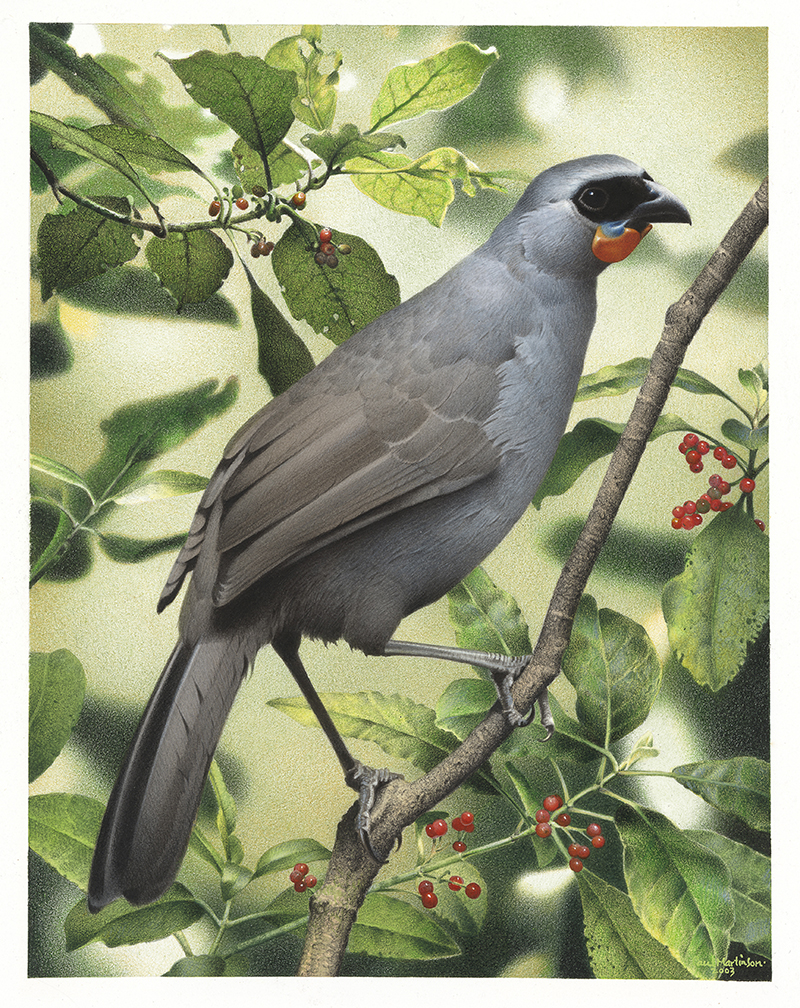
Above: South Island Kokako. Callaeas cinereus. From the series: Extinct Birds of New Zealand., 2003, Masterton, by Paul Martinson. Purchased 2006. © Te Papa. CC BY-NC-ND 4.0. Te Papa (2006-0010-1/10)
References
Original scientific description:
Gmelin, J. F. (1788). Caroli a Linné, Systema naturae per regna tria naturae secundum classes, ordines, genera, species cum characteribus, differentiis, synonymis, locis. Tomus I, part I. Lipsiae: Impensis Georg. Emmanuel Beer.
Other references:
Anmarkrud, Jarl Andreas and Lifjeld, Jan T. (In Press, 2016). Complete mitochondrial genomes of eleven extinct or possibly extinct bird species. Molecular Ecology Resources. DOI: 10.1111/1755-0998.12600 [Abstract]
Anonymous. (1964). List of rare birds, including those thought to be so but of which detailed information is still lacking. IUCN Bulletin 10(Special Supplement): 4 pp.
Bain, H. (2008). Keeping the Kokako's song alive. Forest and Bird: 24-26. [relevant citation?]
Bain, H. (2009). The search for the living dead? Forest and Bird [2009]: 27-29.
Beston, Anne, Hunt in wild south for elusive kokako, The New Zealand Herald, October 10, 2000.
BirdLife International. (2016). Callaeas cinereus. The IUCN Red List of Threatened Species 2016: e.T103730380A94148286. http://dx.doi.org/10.2305/IUCN.UK.2016-3.RLTS.T103730380A94148286.en. Downloaded on 12 November 2017.
Blencowe, Michael. (2021). Gone: A search for what remains of the world's extinct creatures. Leaping Hare Press. 192 pp.
Blencowe, Michael. (2022). Gone: Stories of Extinction. Aurum. 208 pp.
Bonaparte C.-L., 1850: Conspectus generum avium. Vol. 1 (Part 2). Lugduni Batavorum [= Leiden]: E. J. Brill, pp. 273-464.
Buckingham, R. 1985. Search for Kokako on Stewart Island 1984/85. Unpublished report. Dept. of Conservation, Invercargill.
Buckingham, Rhys. (1987). Kokako presence on Stewart Island. Notornis 34(2): 167. [a feather found, two sightings, and calls tape recorded]
Buckingham, Rhys and Lurling, Jeroen. (2014). Search for South Island Kokako, Awaroa Saddle, Abel Tasman National Park, March 2014. Unpublished report.
Buller, W. L. (1888). A history of the birds of New Zealand, 2nd edition. London: Self published.
Butchart, Stuart H. M., Lowe, Stephen, Martin, Rob W., Symes, Andy, Westrip, James R. S. and Wheatley, Hannah. (2018a). Which bird species have gone extinct? A novel quantitative classification approach. Biological Conservation 227: 9-18. https://doi.org/10.1016/j.biocon.2018.08.014
Butchart, Stuart H. M., Wheatley, Hannah, Lowe, Stephen, Westrip, James R. S., Symes, Andy and Martin, Rob W. (2018b). Data for: Which bird species have gone extinct? A novel quantitative classification approach. Mendeley Data, V1, doi: 10.17632/vvjhpmyxb4.1
Chapman, Ann. (1959). Kokako reported from Wilkin Valley, Lake Wanaka. Notornis 8(6): 177-178.
Checklist Committee (OSNZ). (2010). Checklist of the Birds of New Zealand, Norfolk and Macquarie Islands, and the Ross Dependency, Antarctica (4th ed.). Ornithological Society of New Zealand & Te Papa Press, Wellington. [p. 281, 355]
Checklist Committee (OSNZ). (2022). Checklist of the Birds of New Zealand (5th edition). Ornithological Society of New Zealand Occasional Publication No. 1. Wellington: Ornithological Society of New Zealand. [p. 207-208]
Clarkson, David, Hunt for the Grey Ghost, Christchurch Press, November 25, 2000.
Clout, M. N. and Hay, J. R. (1981). South Island Kokako (Callaeas cinerea cinerea) in Nothofagus forest. Notornis 28(4): 256-259.
David, N. & Gosselin, M. 2002. The grammatical gender of avian genera. Bulletin of the British Ornithologists’ Club 122: 257–282.
Dickinson, E.C. & Christidis, L. (Eds). 2014. The Howard & Moore complete checklist of the birds of the world. Fourth edition. Vol. 2, Passerines. Eastbourne, UK: Aves Press. lii + 752 pp.
Dussex, Nicolas et al. (2019). Complete genomes of two extinct New Zealand passerines show responses to climate fluctuations but no evidence for genomic erosion prior to extinction. Biology Letters 15(9): 20190491. [Abstract]
Ewen, John G., Flux, Ian and Ericson, Per G. P. (2006). Systematic affinities of two enigmatic New Zealand passerines of high conservation priority, the hihi or stitchbird Notiomystis cincta and the kokako Callaeas cinerea. Molecular Phylogenetics and Evolution 40(1): 281-284.
Falla, R. A. et al. (1979). The new guide to the birds of New Zealand and outlying islands. Auckland and London: Collins. 256 pp.
Fisher, Diana O. and Humphreys, Aelys M. (2024). Evidence for modern extinction in plants and animals. Biological Conservation 298: 110772. https://doi.org/10.1016/j.biocon.2024.110772
Fulton, R. (1907). The disappearance of the New Zealand birds. Transactions and Proceedings of the New Zealand Institute 40: 485-500.
Ghiraldi, Luca and Aimassi, Giorgio. (2019). Extinct and endangered (‘E&E’) birds in the ornithological collection of the Museum of Zoology of Torino University, Italy. Bulletin of the British Ornithologists’ Club 139(1): 28-45.
Gouraud, Christophe. (2014). Extinct and endangered species and subspecies of birds in the Baillon Collection, La Châtre, France. Journal of the National Museum (Prague), Natural History Series 183(3): 29-38.
Guthrie Smith, H. (1914). Mutton Birds and other birds. Wellington: Whitcombe and Tombs Ltdn.
Guthrie Smith, H. (1925). Birdlife on island and shore. Wellington: W. Blackwood and Sons.
Harper, G. A. (2009). The native forest birds of Stewart Island/Rakiura: patterns of recent declines and extinctions. Notornis 56(2): 63-81.
Higgins P.J., Peter J.M. & Cowling S.J., eds., 2006: Handbook of Australian, New Zealand and Antarctic Birds. Volume 7: Boatbill to Starlings, Part A: Boatbill to Larks. Melbourne: Oxford University Press, 1055 pp.
Holdaway, Richard N., Roberts, Richard G., Beavan-Athfield, Nancy R., Olley, Jon M. and Worthy, Trevor H. (2002). Optical dating of quartz sediments and accelerator massspectrometry 14C dating of bone gelatin and moa eggshell: a comparison of age estimates for non-archaeological deposits in New Zealand. Journal of The Royal Society of New Zealand 32(3): 463-505.
Holdaway, Richard N. and Worthy, Trevor H. (1997). A reappraisal of the late Quaternary fossil vertebrates of Pyramid Valley Swamp, North Canterbury, New Zealand. New Zealand Journal of Zoology 24: 69-121.
Holdaway, Richard N., Worthy, Trevor H. and Tennyson, Alan J. D. (2001). A working list of breeding bird species of the New Zealand region at first human contact. New Zealand Journal of Zoology 28: 119-187.
Holmes, Branden. (2021). What's Lost and What Remains: The Sixth Extinction in 100 Accounts (eBook). Self published.
Hume J.P. & Walters M., 2012: Extinct birds. – London: T & AD Poyser, 544 pp.
Hunt, Elle. (2021, 27 March). 'Wanted, preferably alive': the $10,000 search for New Zealand's 'ghost' bird. The Guardian, available from: https://www.theguardian.com/environment/2021/mar/26/the-search-for-new-zealand-ghost-bird-aoe
Kittelberger, Kyle D., Tanner, Colby J., Buxton, Amy N., Prewett, Amira and Şekercioğlu, Çağan Hakkı. (2024). Correlates of avian extinction timing around the world since 1500 CE. Avian Research 15: 100213. https://doi.org/10.1016/j.avrs.2024.100213 [Supplementary data (List of 216 taxa)]
Knox, Alan G. and Walters, Michael P. (1994). Extinct and endangered birds in the collections of The Natural History Museum. British Ornithologists' Club Occasional Publications 1: 1-292. [pp. 270-271]
Lubbe, Pascale et al. (2022). Mitogenomes resolve the phylogeography and divergence times within the endemic New Zealand Callaeidae (Aves: Passerida). Zoological Journal of the Linnean Society. https://doi.org/10.1093/zoolinnean/zlac060
Martin, Thomas E., Bennett, Gareth C., Fairbairn, Andrew J. and Mooers, A. Ø. (2023). ‘Lost’ taxa and their conservation implications. Animal Conservation 26(1): 14-24. https://doi.org/10.1111/acv.12788 [Appendix S2 (1617 taxa not seen >10 years); Appendix S3 (562 taxa not seen >50 years)]
Martin, W. (1950). Birds on Stewart Island. N. Z. Bird Notes 3(9): 230.
McBride, K. (1981). Sighting of South Island Kokako (Callaeas cinerea cinerea) in Mount Aspiring National Park. Notornis 28(4): 255-256.
Medway, D. G. (1976). Extant types of New Zealand birds from Cook's voyages (Part 2: the type specimens). Notornis 23(2): 120-137.
Milne, Alec and Stocker, Richard. (2014). Evidence for the continued existence of the South Island kokako (Callaeas cinerea) drawn from reports collected between January 1990 and June 2012. Notornis 61(3): 137-143. [supplementary information]
Miskelly, Colin M. et al. (2013). Vagrant and extra-limital bird records accepted by the OSNZ Records Appraisal Committee 2011-2012. Notornis 60(4): 296-306.
Miskelly, Colin M., Forsdick, Natalie J., Gill, Brian J., Palma, Ricardo L., Rawlence, Nicolas J. and Tennyson, Alan J. D. (2022). Amendments to the 2010 Checklist of the birds of New Zealand. Ornithological Society of New Zealand Occasional Publication No. 2. Wellington: Ornithological Society of New Zealand.
Mlíkovský, Jiří. (2012). Extinct and nearly extinct birds in the collections of the National Museum, Prague, Czech Republic. Journal of the National Museum (Prague), Natural History Series 181(9): 95-123. [automatic download]
Murphy, S. A., Flux, I. A. and Double, M.C. (2006). Recent evolutionary history of New Zealand's North and South Island Kokako (Callaeas cinerea) inferred from mitochondrial DNA sequences. Emu 106: 41-48.
Nilsson, Ron J. (2002). The South Island kokako: some thoughts on mystery birds, pieces of moss, feathers and skeptical audiences. Notornis 49(3): 192.
Nilsson, Ron. (2010). The hunt for the grey ghost. Indigena May edition, pp. 5-6.
O'Donnell, C. F. J. and Dilks, P. J. (1986). Forest birds in South Westland, status, distribution and habitat use. Occasional Publication No. 10, NZ Wildlife Service, Department of Internal Affairs, Wellington.
Oliver, W. R. B. (1926). The birds of Stewart Island. New Zealand Journal of Science and Technology 8: 321-341.
Oliver, W. R. B. (1955). New Zealand birds, 2nd edition. Wellington: A. H. & A. W. Reed.
Pascoe, John. (1959). Mr Explorer Douglas. Wellington: A. H. & A. W. Reed.
Philpott, A. (1914). Notes on the birds of south-western Otago. Transactions of the New Zeland Institute 46: 205-212.
Potts, T. H. (1874). On the birds of New Zealand (Part IV). Transactions and Proceedings of the New Zealand Institute 6: 139-153.
Potts, T. H. (1882). Out in the open – a budget of scraps of natural history, gathered in New Zealand. Christchurch: Lyttleton Times Co. 301 pp.
Read, H. E. (1966). Reported sighting of South Island Kokako. Notornis 13(4): 203.
Robertson, H. A., Baird, K. A., Elliott, G. P., Hitchmough, R. A., McArthur, N. J., Makan, T. D., Miskelly, Colin M., O’Donnell, C. F. J., Sagar, P. M., Scofield, R. P., Taylor, G. A. and Michel, P. (2021). Conservation status of birds in Aotearoa New Zealand, 2021. New Zealand Threat Classification Series 36. Department of Conservation, Wellington. 43 pp.
Hugh Robertson, John Dowding, Graeme Elliott, Rod Hitchmough, Colin Miskelly, Colin O’Donnell, Ralph Powlesland, Paul Sagar, Paul Scofield, Graeme Taylor. (2013). Conservation status of New Zealand birds, 2012. New Zealand Threat Classification Series 4. 22 pp.
Salvador RB, Tomotani BM, Miskelly CM, Waugh SM (2019) Historical distribution data of New Zealand endemic families Callaeidae and Notiomystidae (Aves, Passeriformes). Check List 15 (4): 701-727.
Scott, Peter (ed.). (1965). Preliminary List of Rare Mammals and Birds, pp. 155-237. In: The Launching of a New Ark. First Report of the President and Trustees of the World Wildlife Fund. An International Foundation for saving the world's wildlife and wild places 1961-1964. London: Collins.
Seersholm, Frederik V. et al. (2018). Subsistence practices, past biodiversity, and anthropogenic impacts revealed by New Zealand-wide ancient DNA survey. PNAS. https://doi.org/10.1073/pnas.1803573115 [Supplementary information]
Smith, W. W. (1888). On the birds of the Lake Brunner district. Trans. N. Z. Inst. 21: 205-224.
Tennyson, Alan J. D. and Martinson, Paul. (2006). Extinct Birds of New Zealand. Wellington: Te Papa Press.
Traill, R. H. (1927). Letter to the Conservator of State Forests. Dept of Conservation, Invercargill.
Traill, R. H. (1928). Letter to the Conservator of State Forests. Dept of Conservation, Invercargill.
Travers, W. T. L. (1872). Notes on the habits of some birds of New Zealand. Transactions and Proceedings of the New Zealand Institute 4: 206-213.
Tyrberg, Tommy. (2009). Holocene avian extinctions, pp. 63-106. In: Turvey, Samuel T. (ed.). Holocene Extinctions. Oxford, UK & New York, USA: Oxford University Press. xii + 352 pp.
Westerskov, K. E. (1979). Reischek's observations of kokako during his travels in New Zealand, 1877-1889. Forest and Bird 13(3): 7-12.
Williams, G. R. (1962). Extinction and the land and freshwater-inhabiting birds of New Zealand. Notornis 10(1): 15-32.
Williams, H.W. 1971. Dictionary of the Maori language. Seventh edition. Wellington: GP Publications Ltd. xl + 507 pp.
Worthy, Trevor H. (1993). Fossils of Honeycomb Hill. Museum of New Zealand, Te Papa Tongarewa, Wellington. 56 pp.
Worthy, Trevor H. (1997). Fossil deposits in the Hodges Creek Cave System, on the northern foothills of Mt Arthur, Nelson, South Island, New Zealand. Notornis 44(2): 111-124.
Worthy, Trevor H. (1998). Quaternary fossil faunas of Otago, South Island, New Zealand. Journal of the Royal Society of New Zealand 28(3): 421-521. https://doi.org/10.1080/03014223.1998.9517573 [p. 468]
Worthy, Trevor H. (2001). A fossil vertebrate fauna accumulated by laughing owls (Sceloglaux albifacies) on the Gouland Downs, northwest Nelson, South Island. Notornis 48(4): 225-233.
Worthy, Trevor H. and Holdaway, Richard N. (1993). Quaternary fossil faunas from caves in the Punakaiki area, West Coast, South Island, New Zealand. Journal of the Royal Society of New Zealand 23(3): 147-254.
Worthy, Trevor H. and Holdaway, Richard N. (1994). Quaternary fossil faunas from caves in Takaka Valley and on Takaka Hill, northwest Nelson, South Island, New Zealand. Journal of The Royal Society of New Zealand 24(3): 297-391.
Worthy, Trevor H. and Holdaway, Richard N. (2002). The Lost World of the Moa: Prehistoric Life of New Zealand. Bloomington, Indiana: Indiana University Press. xxxiii + 718 pp.
Worthy, Trevor H., Miskelly, Colin M. and Ching, Bob A. (R.). (2002). Taxonomy of North and South Island snipe (Aves: Scolopacidae: Coenocorypha), with analysis of a remarkable collection of snipe bones from Greymouth, New Zealand. New Zealand Journal of Zoology 29(3): 231-244.
Worthy, Trevor H. and Zhao, J. X. (2006). A late Pleistocene predator-accumulated avifauna from Kids Cave, West Coast, South Island, New Zealand. Alcheringa Special Issue 1: 389-408.
http://www.southislandkokako.org/
http://www.nzherald.co.nz/nz/news/article.cfm?c_id=1&objectid=11163639 [recent sightings, one is accepted as a definite sighting]
http://www.osnz.org.nz/sites/osnz.org.nz/files/publications/2014%20Abstracts.pdf
https://www.nzherald.co.nz/the-country/news/article.cfm?c_id=16&objectid=12066913
https://extinctanimals.proboards.com/thread/8710/callaeas-cinerea-south-island-kokako
https://www.rewild.org/news/possibly-heard-and-maybe-seen-the-search-for-the-south-island-k-kako
Acknowledgements
Full attribution of the images courtesy of Museum of New Zealand Te Papa Tongarewa:
[url=http://collections.tepapa.govt.nz/objectdetails.aspx?oid=533792&imagesonly=true]South Island Kokako, Callaeas cinerea cinerea Gmelin, 1788[/url], collection date and precise locality unknown, South Island, New Zealand. Reproduced courtesy of Museum of New Zealand Te Papa Tongarewa under a [url=http://creativecommons.org/licenses/by-nc-nd/3.0/nz/deed.en]CC BY-NC-ND licence[/url].
